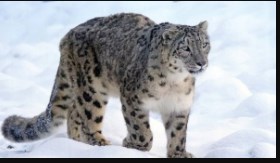Status Report of Snow Leopards in India
The Union Minister of Environment, Forest and Climate Change, Bhupender Yadav, released India’s first nationwide snow leopard population assessment report titled “Status Report of Snow Leopards in India”.
The assessment estimates 718 snow leopards in India based on systematic surveys covering over 70% of their potential habitat from 2019-2023. The Wildlife Institute of India coordinated the Snow Leopard Population Assessment in India (SPAI) program across snow leopard range states.
Survey Methodology
The SPAI used a two-step approach aligned with Ministry guidelines. The first step mapped snow leopard spatial distribution and habitat analysis across ~120,000 sq km using an occupancy survey. The second step estimated abundance through camera traps in identified areas.
Efforts included surveying 13,450 km for signs and deploying cameras at 1,971 locations for 180,000 trap nights. 241 individual snow leopards were photographed. Snow leopard occupancy was recorded across 93,392 sq km, with estimated presence in 100,841 sq km.
State-wise Estimates
Estimated state-wise population is: Ladakh – 477; Uttarakhand – 124; Himachal Pradesh – 51; Arunachal Pradesh – 36; Sikkim – 21; Jammu and Kashmir – 9.
Need for Regular Monitoring
The report highlights the need for a dedicated snow leopard cell at the Wildlife Institute of India under the Ministry to ensure regular monitoring and long-term conservation.
It suggests states adopt assessments every 4 years. Regular range-wide surveys will help address threats and devise effective protection strategies tailored to regional priorities.
Conservation Significance
Until recently, snow leopard ranges in India were poorly defined and studied only across 5% of their habitat. The SPAI has significantly expanded habitat surveys to 80% versus just 56% in 2016.
Robust baseline population data will assist conservation efforts for this vulnerable species facing climate change and human activity pressures.
Broader Context
The survey outcomes can facilitate regional cooperation on snow leopard conservation under initiatives like thevvand Ecosystem Protection Program.
As snow leopards traverse international boundaries, collaboration on combating wildlife trafficking and maintaining habitat connectivity is vital. The report provides a blueprint for conducting scientifically rigorous assessments across the species’ range.
Month: Current Affairs - January, 2024
Category: Environment Current Affairs • Reports & Indexes Current Affairs



